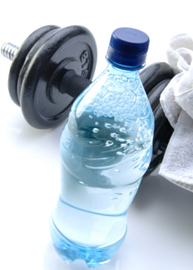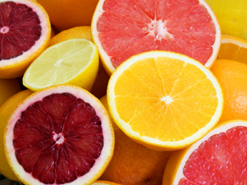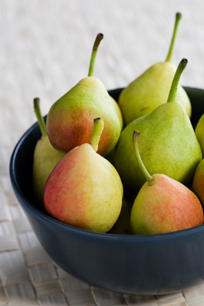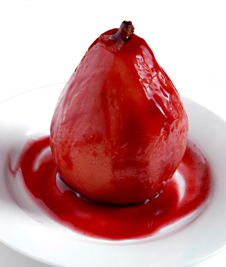Winter 2007: To Your Health
In this Issue:
- Good Digestion Throughout the Holiday Season
- Holiday Cheers! Raising the Glass to Practicing Smart Alcohol Consumption
- Boost Your Immune System the Natural Way
- Key Nutrients to Help You Heal This Winter
- Walk Your Way to Good Health
- Enjoying the Fruits of Winter
- Feature Food of the Month: Pear
- Healthy Recipe: Poached Pears in Cranberry Juice
Good Digestion Throughout the Holiday Season

Festive parties, family and friend get-togethers, lavish foods, champagne and cocktails are all a part of celebrating the holidays. However, these celebrations often involve foods that are high in fat, sugar and calories and can trigger digestive upset. The most common digestive disorder during the holiday season is heartburn (or acid reflux). While certain foods are often the culprit in causing reflux, the lack of exercise and added stress during the holiday season can surely contribute to digestive woes.
Common signs and symptoms of heartburn include a burning sensation in the throat or chest. According to the National Heartburn Alliance, 50 million Americans suffer from frequent heartburn that occurs two or more days per week. For individuals who experience frequent heartburn, this condition is considered gastroesophageal reflux disease (GERD). Further symptoms can include trouble swallowing, chest pain, or a feeling that food is stuck in their throat.
A recent study published in the Journal of Gastroenterology and Hepatology analyzed the impact of body mass index (BMI) on the frequency and severity of reflux and heartburn symptoms. The study analyzed 6,215 patients with GERD, and assessed symptoms of heartburn and regurgitation through a reflux disease questionnaire. The study concluded that individuals with GERD are more likely to experience severe heartburn and regurgitation if they have a high BMI as compared to those of normal weight.
Don’t abandon your healthy eating plan just because the holidays are here. Keep your portions in check and your menu lean, and you are sure to beat the unnecessary weight gain and uncomfortable reflux during the holidays.
References:
Nocon, M et al. “Association of body mass index with heartburn, regurgitation and esophagitis: Results of the Progression of Gastroesophageal Reflux Disease study”. J Gastroenterol Hepatol, 22(11), 1728-1731, 2007.
National Heartburn Alliance.
Click here for more nutrition tips for celebrating the holidays heartburn-free!
Holiday Cheers!
Raising the Glass to Practicing Smart Alcohol Consumption

For many people, having a drink or two is part of celebrating the holiday season. Researchers at the University of Miami suggest that moderate alcohol consumption is not necessarily dangerous, but may rather enhance your health. While researchers are still unsure if it is the alcohol that boosts health or that moderate drinkers may lead healthier lives, the key word to remember is MODERATION. Whatever your drink of choice may be this holiday season, keep in mind the following tips before heading off to your next party:
- Know what is considered “light to moderate” alcohol consumption. According to the U.S. Government’s Dietary Guidelines for Americans (2000), light consumption is defined as three drinks per week for both men and women. Moderate consumption for men is defined as two drinks per day, and one drink per day for women.
- Understand the gender difference. What constitutes moderate consumption for men is more than for women because men and women metabolize alcohol differently. Women will feel the effects of alcohol quicker and for a longer duration than a man, even if they consume equal amounts of alcohol.
- Know your tolerance level. According to the National Clearinghouse for Alcohol and Drug Information, it only takes about 1-2 drinks to alter a person’s judgment and reflexes. Be sure to have a designated driver when attending gatherings, or opt to abstain from drinking altogether to ensure your safety this holiday season.
- Read prescription labels carefully! If you are on any prescription medications, read all labels carefully and consult your physician or pharmacist regarding any possible interactions before drinking any alcohol.
- Be aware of the relationship between alcohol and food. During the holidays, alcohol consumption typically increases and can make you less aware of how much you are actually eating. To ensure that you do not over-consume alcohol or food, have a plan before attending gatherings.
Reference: “Nutrition and Your Health: Dietary Guidelines for Americans.” United States Department of Agriculture (USDA). 2005.
Alcohol is light on nutrition and heavy on the calories! Visit our special web section for examples of some common alcoholic beverages and how their calories stack up.
Boost Your Immune System the Natural Way

Your immune system plays a large role in keeping your body healthy. If you are healthy and your immune system is functioning to its fullest potential, it is possible to avoid catching a cold or the flu this winter. Below are some natural strategies you can use to help protect your body from getting sick:
- Drink plenty of fluids. Most individuals need 8-10 glasses of water daily in order to flush out their system and re-hydrate their body. A good indicator if you are drinking enough fluid is the color of your urine. Typically, if it is deep yellow in color it indicates you may need to drink more fluids. If your urine is close to clear, you can be confident that you’re getting enough.
- Exercise regularly. Aerobic exercise strengthens your body’s immune system in three ways: it enables you to breathe faster for quicker oxygen transfer from your lungs to your blood, it speeds up your heart to pump larger quantities of blood, and rids your body of toxins through sweat. Exercise also increases the body’s natural virus-killing cells.
- Consume foods with phytochemicals. Plant-based foods contain natural chemicals called phytochemicals that are a great source of antioxidants, vitamins and minerals. To reap the benefits, consume red, yellow, orange, and dark green fruits and vegetables regularly.
- Limit alcohol intake. Alcohol takes more fluids from your system than it actually puts in and thus dehydrates the body. In addition, heavy alcohol use destroys the liver—the main detoxifying system of the body—and can inhibit the filtering of germs.
- Kick the habit of cigarette smoking. Cigarette smoke (primary or secondary) inhibits the function of the immune system tremendously. More importantly, it paralyzes cilia (tiny hair-like structures) that line your nasal and lung passages that typically rid the body of cold and flu viruses. Statistics have shown that smokers are more likely to catch more frequent and severe colds the longer they continue this harmful habit.
- Wash your hands! Most cold and flu germs are contracted directly from the source—for example, from someone who sneezes and touches a phone or door knob. Germs can survive in a given location for hours and even weeks, so it’s important to wash your hands frequently. If there is no restroom or sink with soap around, try an alcohol-based hand sanitizer or antibacterial hand wipes to avoid germs when on the go.
- Use a tissue! Cold and flu viruses can remain on your hands after you cough or sneeze, and are thus easier to pass from person to person. Instead, use a tissue when you sneeze or cough and throw it away immediately. Carry pocket tissues in your car and while on the go and you could avoid getting ill this winter!
- Get fresh air. It’s typical to want to remain indoors during the cold winter months, but fresh air is key to keeping yourself healthy. It is easier for germs to circulate indoors, especially in a room full of people, so opt for a quick breath of fresh air at your next winter gathering.
- Learn to relax. Constant stress can weaken your immune system over time, so it’s important to incorporate time to relax into your daily routine. Research suggests that when you are relaxed, the amount of interleukins (a chemical that helps to fight against cold and flu viruses) increases. Whether it’s reading a good book, walking your dog, or taking a yoga class, find something you enjoy and include it into your daily relaxation routine.
Reference: WebMD
Click here for more information on phytochemicals, their functions, and food sources.
Key Nutrients to Help You Heal This Winter

The holidays unofficially mark the beginning of cold and flu season, and often, stress and fatigue. Your body responds to this stress by producing stress hormones, but an overload can result in the wear down of your body and immune system, making you more susceptible to colds and viruses. By fueling your body with the nutrients it requires to remain healthy, you can reduce the amount of stress hormones, boost your natural defenses, and remain healthier overall. Below are some key nutrients that will help heal your body this winter:
Protein
Protein is essential for growth and repair, nerve impulse transmission, muscle and immune protection, and is responsible for all biological processes. When your body is under stress, your protein needs increase in order to allow for appropriate healing. Choosing high quality proteins to include in your diet is the best way to meet your increased protein needs to ensure your body heals properly. These foods include lean meats, poultry, fish, eggs, as well as milk, yogurt and cheese. Vegetarians may opt for tofu, soymilk, peanuts, and chickpeas for additional protein. Consuming protein prior to exercising also helps to reduce the incidence of muscle injury, in addition to carbohydrates which provides the main fuel that muscles burn. Ideally, include both a protein and a carbohydrate before exercising for optimal results.
Calories
Following a high-nutrient, low-calorie lifestyle is ideal for promoting immune system health to help you through metabolic stress. Foods to include are whole grains, lean meat, fruits, vegetables, and low-fat dairy foods. When your body undergoes a period of metabolic stress, it requires energy in the form of calories to help heal the body and to ensure that protein isn’t burned for calories, but rather is available for muscle repair.
Omega-3 Fatty Acids
The type of fat consumed seems to have a large effect on the body’s healing process. Omega-3 fatty acids—a type of polyunsaturated fatty acid—have an anti-inflammatory effect on the body. Omega-6 fatty acids (found in vegetable oil, seeds and nuts) are pro-inflammatory. Thus, one should decrease their Omega-6 intake and increase Omega-3. Omega-3 fatty acids also help to regulate mood by increasing serotonin levels which helps fight depression. Food sources of Omega-3 fatty acids include fatty, cold water fish such as Atlantic salmon, sardines, mackerel and tuna, as well as walnuts and flaxseed. Try to include two to three 3-ounce servings of fatty fish per week to reap the benefits of this stress-reducing fat.
Antioxidants
Antioxidants are substances that protect cells from free radicals and include vitamins C, E, and A, lycopene and beta carotene. Fruits that are rich in antioxidants include pomegranate, grapes, plums, and oranges. Vegetables that are rich in antioxidants include chile peppers, orange and yellow bell peppers, kale, red cabbage, spinach, Brussels sprouts, and parsley. To ensure that you are reaping the benefits of these antioxidants, try adding a mixed green salad and other plant foods into your daily diet. In addition, try carrot sticks, bell pepper strips, or grapes for an afternoon snack, or add berries to your morning cereal or oatmeal.
Minerals
The three most important minerals for strengthening the immune system and wound healing include magnesium, zinc, and selenium. Magnesium stores in your body are easily reduced by stress and the consumption of fatty foods, sugar, alcohol and caffeine. Boost your levels by including nuts, seeds, whole grains, and leafy vegetables in your diet. Food sources of zinc include meat, seafood, liver, eggs, milk, and whole grains. Food sources of selenium include red meat, fish/shellfish, eggs, chicken, garlic, and whole grains.
Keep in mind that there is no single food that can nourish your body and heal all of your ailments, but rather it is a combination of whole, natural foods. Limit your intake of processed foods and you will have the energy and ability to think clearly to be able to handle whatever life throws your way!
Reference: Bareuther, Carol. “Foods to Help You Mend.” Today’s Diet & Nutrition. 20 Nov 2007
Visit our special web section on the functions of Omega-3 Fatty Acids and their food sources.
Walk Your Way to Good Health

With the business of the holiday season at hand, sticking with your exercise may pose a challenge. However, just because you can’t seem to find time to get to the gym doesn’t mean you have to skip your whole regimen entirely. Walking can be an easy way to get in your exercise even on your busiest day, whether it’s indoors or outdoors. All that’s required is a pair of shoes, warm and comfortable clothing, and the motivation to stay active this holiday season!
Many of us are motivated by different things and it’s useful to figure them out before beginning an exercise program. Make one list of the benefits you will receive from your program, and another of the people in your life that will benefit. In addition, it may be beneficial to list the excuses you have for not exercising, and each day make it a goal to remove each of these excuses from your list. The key point to remember is that in order to reach your goal you have to make yourself and fitness a priority.
Benefits of Walking:
- It’s free!
- It can be done anywhere and without any equipment
- It burns calories and can help you lose weight
- It is easy on your joints, yet helps strengthen your bones
- It reduces stress and can help you sleep better at night
- It shapes and tones your lower body
- It improves your mood and your outlook on life
- It can help reduce your cholesterol and reduce your risk of developing heart disease
Always check with your doctor before beginning any exercise program
Tips on How to Begin a Fitness Walking Program
- Decide upon your reasons for walking—is it for general health benefits, to improve cardiovascular fitness, or for weight loss?
- Walking for General Health Benefits: Aim to walk for 30 minutes a day (or most days of the week) and keep it at a pace that is comfortable enough to hold a conversation.
- Walking for Cardiovascular Fitness: Aim to walk 3-4 days per week for 30 minutes at a fast pace where you are breathing hard but not gasping for air.
- Walking for Weight Loss: Aim to walk for a minimum of 5 days per week for 45-60 minutes at a brisk pace.
- It’s important to ease into any fitness program and to start out slowly. Begin by walking for 10-15 minutes every day for a week. If it seems easy for you, add another 5 to 10 minutes the next week, and keep adding 5 minutes until you reach your goal.
- Although walking is safe and effective since it is a low-impact form of exercise, it’s still important to warm up your muscles before you begin to prevent injury and muscle stiffness.
- The most effective way of warming up is to walk at a normal pace for 5 minutes before taking it up to a brisker pace. It enables your body to slowly increase your heart rate, blood circulation, and breathing.
- While walking, focus on your posture and make sure that you are walking tall. Picture yourself elongating your spinal cord, holding your head up and looking forward. Your shoulders should be down and relaxed, and your abdominal muscles contracted.
- Drink plenty of water before, during, and after you exercise. If you are walking for 30 minutes or more, take your water with you and take a drink every 15 minutes.
- End your workout with a 5 minute cool-down session by slowing down your pace back to normal. This will ensure that your heart rate and breathing rate return to normal, and will reduce the incidence of lactic acid buildup in the muscles which can cause muscle cramps and soreness.
For tips on exercising safely outdoors in the winter, please visit our special web section
Click here for information about the proper walking gear for your workouts.
January 20-26, 2008 is National Healthy Weight Week!
Make the commitment this week to begin a healthy eating plan for weight loss and to prevent weight-related health problems.
Click here to see how Bonnie R. Giller, MS, RD, CDN, CDE can help!
Enjoying the Fruits of Winter

There is no more perfect time than the holidays to serve fruit! They can add freshness, color and flavor to any holiday menu, as well as offer a balance to the typical high calorie foods eaten at this time of year. There are many varieties of exotic fruits available during the winter months and it’s important to know how to pick, store, and best enjoy each one!
- Clementine: Rich in vitamin C, clementines are known as the ultimate portable fruit since they peel easily, are typically seedless, and break cleanly into sections. You’ll often find them in supermarkets from December through January and they last about a week in the refrigerator. Their sweet, yet slightly tart flavor makes them a favorite for both children and adults.
- Grapefruit: Another excellent source of vitamin C, grapefruits come in a variety of colors: red, white, and pink, and their flavors range from bitter to sweet and tart. When shopping for grapefruits, choose one that feels heavier for its size and gives slightly when it’s squeezed. In addition, search for one with an unblemished peel to ensure that you are picking the best quality grapefruit.
- Kumquat: As a good source of dietary fiber and vitamin C, this fruit resembles an oval orange and the colors can range from yellow to red. They are typically in season from late autumn to mid-winter, and they have a sweet skin and tart flesh. The fruit is considered ripe when it reaches a yellow-orange color, and is often found as candied and as preserves such as marmalade and jelly. When shopping for kumquats, it’s best to buy the firm fruits. Typically, the fruit can last up to 2 weeks when refrigerated, but they can be stored at room temperature if they will be eaten within a few days.
- Quince: Rich in vitamin A, dietary fiber, and iron, quinces are known as a highly aromatic fruit and are great for both display and cooking. When cooked, they typically turn a pale-apricot color with a firm texture, and taste like a cross between a pear and an apple. Their high pectin content makes them perfect for jellies and jams. Quinces are available from late autumn to early winter and can be kept for 2-3 months when refrigerated. When shopping for quinces, the best indicator of ripeness is a slight aroma. They can be eaten after peeling and coring, just as you would a pear or apple.
- Pomegranate: As a good source of vitamin C and potassium, this fruit has a distinct ruby-red pulp, a tremendous amount of seeds, and an intense sweet, yet tart flavor. They are available from early autumn through December, and can last up to 3 months when refrigerated. When shopping for pomegranates, search for large, heavy, and richly colored fruit to ensure that it has the most juice. The skin should be thin, tough, and free of blemishes. Pomegranate seeds are perfect for seasoning foods, and can be added to creamy desserts and salads.
References:
“All About Winter Fruit.” CookingLight. 2007.
Magee, Elaine. “Winter: Prime Time for Festive Fruit.” MedicineNet. 24 Oct 2007
Click here for ideas on how to add fruit to the festivities.
Feature Food of the Month: Pear

Pears are the ultimate winter fruit! Oregon and Washington are the two leading states that produce most of the nation’s pears. They typically have a bell shape and their colors can range from light green to gold to brown. In addition, their flavors range from sweet to tart due to the many variations of pears. Below are the most popular varieties of pears and their characteristics:
- Bartletts: Juicy and sweet in flavor
- Bosc: Sweet, creamy flavor with a crunchy skin
- Anjou: Juicy and sweet, yet mildly spicy; great for salads!
- Comice: Juicy and sweet with a reddish tone on their skin
- Forelle: Juicy and sweet with freckled skin to indicate their ripeness
- Seckel: Sweet aromatic flavor, yet someone spicy; Smallest pear variety.
- Red Varieties: Many varieties of red pears exist, and each has their own distinct flavor.
Fresh pears are a good source of dietary fiber, potassium, and vitamin C. Typically one medium pear contains 100 calories, 6 grams of dietary fiber, 190 mg of potassium, and 7 mg of vitamin C. Vitamin C promotes healthy gums and teeth, aids iron absorption thereby helping in the prevention of anemia, maintains connective tissue, aids in the healing of wounds and helps to maintain proper immune function. In addition, potassium is an electrolyte that helps lower blood pressure, regulates muscle contractions, and transmits nerve impulses. Diets low in fat, rich in fiber, and fruits and vegetables helps to reduce the risk of coronary heart disease. While remembering American Heart Month this February, try our tasty Poached Pears in Cranberry Juice recipe below, and keep in mind how good for your heart this tasty winter fruit is!
Reference: “Fresh Pears Nutritional Information.” USA Pears. 2007.
Healthy Recipe – Poached Pears in Cranberry Juice

Add some variety to your holiday dessert menu with the sweet and tart flavors of pears and cranberries! This recipe adds wonderful color and is full of flavor and nutrition—the perfect ending to a hearty meal!
Ingredients:
1 ½ cups fresh cranberries, rinsed and picked over
2 cups apple juice (no sugar added)
1 tablespoon honey
4 large, firm, almost-ripe Bartlett or d’Anjou pears (about 2 pounds), halved, cored, and peeled
1/4 teaspoon cinnamon
1/8 teaspoon ground cardamom or nutmeg
2 packets Splenda
1/4 teaspoon almond extract
Instructions:
- Put cranberries and apple juice in a 3-quart heavy-bottom saucepan. Bring to a boil.
Reduce heat to simmering. Cover and cook until all the berries pop (about 7 minutes). In a bowl, press out juices with a large spoon. Stir honey into juices. Discard solids. - Arrange pears in layers in saucepan, rounded sides down. Cover with cranberry liquid.
Bring to a boil. Reduce heat to simmering. Cover and simmer until firm-tender (about 10 minutes). Sprinkle with spices. Gently spoon liquid over pears. Uncover and let stand for 10 minutes. - With slotted spoon, transfer pears to a 3-quart covered bowl. Add Splenda to juices,
stirring until dissolved, and pour over fruit. Cover and refrigerate several hours (or
overnight) to permit flavors to develop fully.
Yield: 8 Servings
Serving Size: 1 serving (1/2 pear)
Exchange: 2 Fruits
Nutrition Facts:
Calories = 109
Total Fat = 1 gram
Saturated Fat = 0 grams
Cholesterol = 0 grams
Carbohydrate = 27 grams
Protein = 1 gram
Sodium = 2 mg
Dietary fiber = 4 grams
For more healthy recipes, click here.

Leave a Reply
Want to join the discussion?Feel free to contribute!